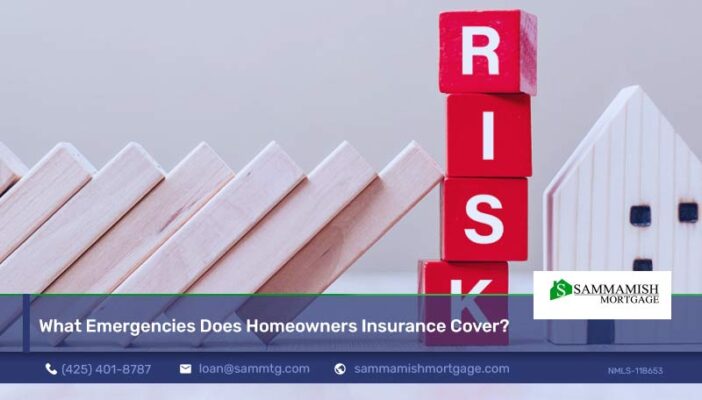No Obligation and transparency 24/7. Instantly compare live rates and costs from our network of lenders across the country. Real-time accurate rates and closing costs for a variety of loan programs custom to your specific situation.

Being a homeowner comes with additional responsibilities. Homeowners insurance will typically be required by your lender, but it’s not just designed to help them recoup their loan amount if something happens to your home. This type of coverage can protect you and your belongings as well, but does homeowners insurance cover emergencies?
Depending on where you live, you may be subject to a higher risk for specific types of natural disasters. In these cases, you can typically purchase additional insurance policies or rivers that provide you with coverage in case catastrophe strikes.
Homeowners insurance policies are designed to mitigate the cost of damage done by “covered perils”. Most policies specifically lay out what is a covered peril, and anything not listed is assumed not to be covered. This is why it’s so important to read your policy carefully and ask about any additional insurance coverage that can be added by way of an extra policy or an add-on to your main policy, known as a rider.
The most common types of covered perils listed in a standard homeowners insurance policy (known as an HO3 policy) include:
If you live in certain regions, you might be at risk for specific kinds of events, such as:
You might also want to secure coverage for events that may happen over a period of time but then become an emergency when damage comes to light:
Depending on the insurance company, you may be able to get riders or separate policies to cover some of these types of emergencies. If your insurer doesn’t offer coverage, you may be able to find a specialty insurer or a government funded entity (typically available for flood policies if local insurers don’t offer flood, the property has an existing history of filed claims for flood, or flood cover from major insurers is too expensive.)
In most cases, damage caused by acts of war are not covered, and certain types of natural disasters may not be insurable against in your area. Your homeowners insurance also is unlikely to cover damage caused by a home emergency not listed in the policy, such as the unlikely event of a wild animal attacking your home.
Your standard HO3 homeowners insurance policy is usually sufficient. This type of policy is the most common type of dwelling coverage offered in the United States. The base policy and commonly offered riders cove the cost of repairing or replacing:
Compare not just quotes, but actual listed coverage across different policies and insurers before buying home insurance. One thing in particular to look for is whether the policy gives you the value of the home, or the amount needed to rebuild at the current market cost of labor and materials if it is completely destroyed.
You can help mitigate risk of certain types of home emergencies and lower your insurance premiums at the same time. Consider the following:
Some insurers will give you a discount if you show that you’re hooked into a security system that will alert emergency services if there is a break-in or a fire. Since there is less chance of serious damage being done with an early warning system in place, your insurer can award you a slightly lower premium.
If you live in a gated community, it’s also assumed that your home is safer both from break-ins and from damage by fire or smoke. If you buy into a gated community, ask if you qualify for a home insurance discount.
If you have a roof that overhangs the outer walls of your home, it’s easier for the wind to rip your roof off from underneath. Having a hip roof (one that meets the top edge of your outside wall, usually with a gutter running along the seam) can often qualify you for a premium discount.
You can also reinforce your home with strong materials from wind-resistant storm doors to hail-resistant roofing. Ask your insurer if you can get a lower premium when your builder uses these types of materials.
A smart home can include sensors that warn when there is rising humidity due to a water leak, warn you about rising temperature levels or worsening air quality when you aren’t home, and allow you to check door and window locks remotely. These types of technologically advanced systems can also reduce your homeowners insurance bills.
You can also get a lower premium by raising your deductible (only do this if you can stash away enough cash to cover the cost of the higher deductible in case of a claim), or by paying your entire annual premium in a single payment (as opposed to dividing it into multiple payments spaced out over the course of a year.)
The best way to deal with emergencies as a homeowner is to be as prepared as possible. In addition to keeping your property properly maintained, you should also be fully prepared for the claims process if you ever need to file.
Knowing what emergencies home insurance covers and what isn’t covered under a typical policy can help you plan and prepare for worst case scenarios. Educating yourself on what standard policies and riders cover as well as what additional policies may be available from insurers in your area can help you in your purchasing decision.
If you are buying insurance to meet requirements from your home mortgage lender, make sure you obtain their list of minimum coverage amounts and overbuy if possible. It’s always better to have more than enough insurance than to find yourself falling short in case of a homeowner emergency.
At Sammamish Mortgage, we make homebuying easy. Once you’ve secured your perfect home and obtained the mortgage you need to make your home purchase happen, we continue to support you throughout your homeownership journey with helpful blogs like this one.
Sammamish Mortgage has been in business since 1992, and has assisted many homebuyers in the Pacific Northwest. If you are looking for mortgage financing in Washington State, we can help you get preapproved. Sammamish Mortgage offers mortgage programs in Colorado, Idaho, Oregon, and Washington.
Contact a loan officer if you have any mortgage-related questions or concerns. If you are ready to move forward, you can view rates, obtain a customized instant rate quote, or apply instantly directly from our website.


Whether you’re buying a home or ready to refinance, our professionals can help.
{hours_open} - {hours_closed} Pacific
No Obligation and transparency 24/7. Instantly compare live rates and costs from our network of lenders across the country. Real-time accurate rates and closing costs for a variety of loan programs custom to your specific situation.